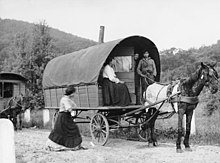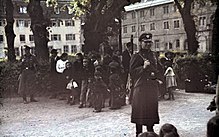Sinti
You can help expand this article with text translated from the corresponding article in German. (January 2023) Click [show] for important translation instructions.
|
| Total population | |
|---|---|
| approx. 200,000[1] | |
| Languages | |
| Sinte Romani | |
| Related ethnic groups | |
| Other Indo-Aryan peoples, especially Roma (Manouche) |

The Sinti (also Sinta or Sinte; masc. sing. Sinto; fem. sing. Sintesa) are a subgroup of Romani people. They are found mostly in Germany, France and Italy and Central Europe, numbering some 200,000 people.[1][2][3] They were traditionally itinerant, but today only a small percentage of Sinti remain unsettled. In earlier times, they frequently lived on the outskirts of communities.
The Sinti of Central Europe are closely related to the group known as Manouche in France.[4] They speak the Sinti-Manouche variety of Romani, which exhibits strong German influence.[1][4]
Etymology and origin
The origin of the Sinti people, as with the broader Romani people, lies generally in the Indian subcontinent. While people from the western Indian subcontinent's Sindh region were mentioned in 1100 by Ahmad ibn Muhammad al-Maydani, it is unclear whether the Sindhi people were the ancestors of modern Sinti, though it is clear that Sinti and other Romani people originated in the northern Indian subcontinent.[5][6]
The origin of the name is disputed.[7] Scholar Jan Kochanowski, and many Sinti themselves, believed it derives from Sindhi, the name of a people of Sindh in medieval India (a region now in southeast Pakistan).[5][8] Scholar Yaron Matras argued that Sinti is a later term in use by the Sinti from only the 18th century on, and is likely a European loanword.[9][8] This view is shared by Romani linguist Ronald Lee who stated the name's origin probably lies in the German word Reisende meaning 'travellers'.[10]
A recent study by Estonian and Indian researchers found genetic similarities between European Romani men and Indian men in their sample.[11] Linguist N. B. G. Kazi stated that all Romani people are from Sindh.[12]
History
The Sinti are a subgroup of Romani people mostly found in Germany.[2] They arrived in Austria and Germany in the Late Middle Ages as part of the Romani emigration from the Indian Subcontinent,[13] eventually splitting into two groups: Eftavagarja ("the Seven Caravans") and Estraxarja ("from Austria").[14] They arrived in Germany before 1540.[15] The two groups expanded, the Eftavagarja into France and Portugal, where they are called "Manouches", and to Brazil, where they are called "Ciganos" (from Italian "zingaro"); and the Estraxarja into Italy and Central Europe, mainly what are now Croatia, Slovenia, Hungary, Romania, the Czech Republic and Slovakia, eventually adopting various regional names.[16]
The Holocaust

The Sinti migrated to Germany in the early 15th century. Despite their long presence, they were still generally regarded as beggars and thieves, and, by 1899, the police kept a central register on Sinti, Roma, and Yenish peoples. Nazi Germany considered them racially inferior (see Nazism and race), and persecuted them throughout Germany during the Nazi period – the Nuremberg Laws of 1935 often being interpreted to apply to them as well as the Jews.[17]
Adolf Eichmann recommended that Nazi Germany solve the "Gypsy Question" simultaneously with the Jewish Question, resulting in the deportation of the Sinti to clear room to build homes for ethnic Germans.[18] Some were sent to Poland, or elsewhere (including some deported to Yugoslavia by the Hamburg Police in 1939[19]) others were confined to designated areas, and many were eventually murdered in gas chambers.[20] Many Sinti and Roma were taken to Auschwitz-Birkenau, where they were put in a special section, called the "gypsy camp". Josef Mengele often performed some of his infamous experiments on Sinti and Roma. On 2 August 1944, the "gypsy camp" was closed, and approximately 4,000 Sinti and Roma were gassed during the night of 2–3 August and burnt in the crematoria. The date 2 August is commemorated as Roma and Sinti Holocaust Remembrance Day.[21]
In the concentration camps, the Sinti were forced to wear either a black triangle, indicating their classification as "asocial",[22] or a brown triangle, specifically reserved for Sinti, Roma, and Yenish peoples.




See also
- Antiziganism
- History of the Romani people
- Romani people by country
- Romani people in Austria
- Romani people in Germany
- Romani people in the Netherlands
- Sindhi diaspora
- Sinte Romani (language)
Citations
- ^ a b c Grimes, Barbara F. (May 2003). "Central Indo-Aryan Languages". In Frawley, William (ed.). International Encyclopedia of Linguistics. Vol. 1 (2nd ed.). New York City: Oxford University Press. p. 295. doi:10.1093/acref/9780195139778.001.0001. ISBN 978-0-19-513977-8.
- ^ a b Kalaydjieva, Luba; Gresham, David; Calafell, Francesc (2 April 2001). "Genetic studies of the Roma (Gypsies): A Review". BioMed Central Medical Genetics. 2 (5): 5. doi:10.1186/1471-2350-2-5. PMC 31389. PMID 11299048.
Individual groups can be classified into major metagroups: the Roma of East European extraction; the Sinti in Germany and Manouches in France and Catalonia; the Kaló in Spain, Ciganos in Portugal and Gitans of southern France; and the Romanichals of Britain.
- ^ Hübshmanová, Milena (2003). "Roma—Sub Ethnic Groups". Uni-Graz.at. University of Graz.
- ^ a b Margalit, Gilad; Matras, Yaron (2007). "Gypsies in Germany-German Gypsies? Identity and Politics of Sinti and Roma in Germany". In Stauber, Roni; Vago, Raphael (eds.). The Roma: A Minority in Europe: Historical, Political and Social Perspectives. Budapest: Central European University Press. pp. 103–116. ISBN 978-1-4294-6253-2. OCLC 191940451.
- ^ a b Kenrick, Donald (2004). Gypsies: From the Ganges to the Thames. University Of Hertfordshire Press. p. 27. ISBN 1902806239.
- ^ Sturman, Janet (26 February 2019). The SAGE International Encyclopedia of Music and Culture. SAGE Publications. ISBN 978-1-5063-5337-1.
The ancestors of today's 12 to 15 million Roma came from India about 1,000 years ago, and their descendants eventually migrated to six continents. The Romanic language language is most closely related to Punjabi and Hindi and is still spoken by millions of Roma and Sinti (Romani people of Central Europe).
- ^ Stauber, Roni; Vago, Raphael (January 1, 2007). The Roma: a Minority in Europe: Historical, Political and Social Perspectives. Central European University Press. ISBN 978-963-7326-86-8.
Already in 18th and 19th century scholarly discussions, the name 'Sinti' was associated occasionally with that of the Indian province of Sindh. There is, in fact, no connection at all. The word 'Sinti' has the inflection typical of a European loanword in Romani, and cannot have been part of the original Indian vocabulary of the language. The fact that it is found solely among Romani speakers in Germany and neighboring regions and only more recent sources, suggests that it is a later borrowing into this specific dialect of Romanic, and was not part of the language in pre-European times.
- ^ a b Matras, Yaron (2004). "The Role of Language in Mystifying and Demystifying Gypsy Identity". In Saul, Nicholas; Tebbut, Susan (eds.). The Role of the Romanies. Liverpool University Press. p. 70. ISBN 9780853236795.
- ^ Margalit, Gilad; Matras, Yaron (2007). "Gypsies in Germany-German Gypsies? Identity and Politics of Sinti and Roma in German". In Stauber, Roni; Vago, Raphael (eds.). The Roma: A Minority in Europe: Historical, Political and Social Perspectives. Budapest: Central European University Press. p. 105. ISBN 978-1-4294-6253-2. OCLC 191940451.
[U]p to the late 18th century the Sinti referred to themselves as 'Kale' (lit. 'blacks'). The term 'Sinti' or 'Sinte' (see below) may be found in 18th and 19th century linguistic documentation alongside 'Kale,' and appears to have been borrowed from the secret vocabulary of the Yenish travelers, perhaps because of its usefulness in concealing ethnic identity. Only toward the late 19th century does the self-appellation 'Sinti' replace 'Kale' entirely in Germany.
- ^ "'A New Look at Our Romani Origins and Diaspora' by Ronald Lee". Kopachi.com. Retrieved 2022-07-14.
- ^ Nelson, Dean (3 December 2012). "European Roma descended from Indian 'untouchables', genetic study shows". The Telegraph. Retrieved 15 December 2017.
- ^ "Gypsies hail from Sindh, claims Dr.Kazi". Pakistan: Dawn. 25 September 2006.
- ^ "Europe invented 'gypsies,' says German author". Deutsche Welle. Retrieved 15 March 2014.
- ^ Innsbrucker Beiträge zur Kulturwissenschaft: Sonderheft. 1993. ISBN 978-3-85124-165-5.
- ^ Nicholas Saul, Susan Tebbutt, p. 182
- ^ Szombati, Kristóf (June 12, 2018). The Revolt of the Provinces: Anti-Gypsyism and Right-Wing Politics in Hungary. Berghahn Books. ISBN 978-1-78533-897-7 – via Google Books.
- ^ "Targeting the Sinti and Roma". Retrieved June 13, 2021.
- ^ Burleigh, The Racial State, p. 122.
- ^ Michael Burleigh and Wolfgang Wipperman, The Racial State: Germany 1933–1945 (Cambridge, England: Cambridge University Press, 2002), 117.
- ^ Davis, Mark (5 May 2015). "How World War II shaped modern Germany". euronews.
- ^ "European Roma Holocaust Memorial Day: Statement by President von der Leyen, Vice-President Jourová and Commissioner Dalli". European Commission. Archived from the original on 26 May 2021. Retrieved 22 May 2021.
- ^ Shapiro, Paul A.; Ehrenreich, Robert M. (2002). "brown+triangle" Roma and Sinti: under-studied victims of Nazism: symposium proceedings. Center for Advanced Holocaust Studies, United States Holocaust Memorial Museum. p. 24. Retrieved 2010-06-26.
General and cited references
- Saul, Nicholas; Tebbutt, Susan, eds. (2004). The role of the Romanies: images and counter-images of 'Gypsies'/Romanies in European cultures. Liverpool: Liverpool Univ. Press. ISBN 978-0-85323-679-5.
Further reading
- Walter Winter, Struan Robertson (translator). Winter Time: Memoirs of a German Who Survived Auschwitz. Hertfordshire Publications, (2004), ISBN 1-902806-38-7.
- Reviewed by Emma Brockes: "We had the same pain", The Guardian, November 29, 2004.
- Sinti and Roma: Gypsies in German-speaking Society and Literature
- Sinti and Roma: Legal Status and Perspectives for a European Minority
- Roma in Europe: The Politics of Collective Identity Formation
External links
- Non-Jewish Victims of Persecution in Nazi Germany on the Yad Vashem website
- Wege nach Ravensbrück (Ravensbrück concentration camp: Memories of surviving female Sinti) (in German)
- F. N. Finck, Lehrbuch des Dialekts der deutschen Zigeuner (1903) in the Internet Archive (in German)
